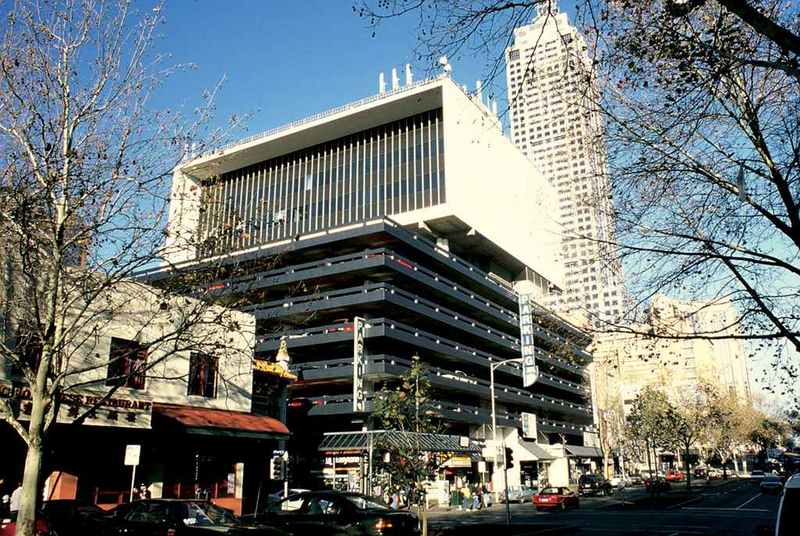Total House heritage registration to be challenged by owners at Supreme Court

Following the Heritage Council registration hearing in February this year, Total House (located 170 Russell Street, corner of Little Bourke Street, Melbourne) was due to be gazetted to the Victorian Heritage Register. Total House was designed by the architectural firm Bogle Banfield Associates and completed in 1965. It has long been regarded as a modernist architectural landmark, being included in various (unimplemented) heritage studies, and described by architectural historian Prof. Philip Goad in Melbourne Architecture as one of Melbourne’s best Japanese-inspired Brutalist buildings. It is also possibly the first building in Australia to employ a multi-storey carpark and office building above, shops at ground level and a basement-level theatre.The National Trust appeared at the Heritage Council hearing in support of the registration with an expert witness (architectural historian Simon Reeves, who specialises in the heritage of the modern movement) and with Susan Brennan SC as our advocate. The owners, Sovereign Plaza (Chinatown) Pty Ltd, want to built a 70-storey 260m tower on the site, and adding the building to the Victorian Heritage Register would pose a considerable hurdle in the way of redevelopment.
In July 2014 the owners lodged a Supreme Court writ claiming that the Heritage Council has erred in its application of law in adding the building to the Register. The preliminary hearing was held on 8 August 2014, and as reported in The Age the full matter is likely to be heard in February 2015. The aspect of the Heritage Act being challenged is the long-established principle that there is a two-stage process in these matters, which clearly separates out consideration of economic factors between registration decisions and permit decisions. Economic considerations are reserved for the permit process.
The looming Supreme Court action is a challenge to both the application of the Heritage Act and the place of post-war modernism in heritage assessments. Whilst the defence of the original decision has been delegated by the Heritage Council to the Executive Director of Heritage Victoria (because the matter may yet come back to the Heritage Council) and the Executive Director and Heritage Council clearly both want to fight this matter hard, it is unclear what appetite the Minister for Planning has for the technicalities of this issue, particularly given his public disdain for supposedly ‘ugly’ post-war heritage.
Postwar modernism in Melbourne had many international influences, and Total House is significant as a very early expression of Japanese-inspired ‘Brutalist’ architecture in Victoria, with its bold expression and unpainted concrete surfaces influenced by Japanese avant-garde architecture of the late-1950s and early-1960s. The strong cantilevered horizontals of the seven storeys of carpark decks are topped by the distinctive floating office block on cantilevered supports. Total House is also important as one a rush of carparks built between 1955 and 1966 in response to the huge rise in car use and consequent city congestion. This is one of a number that were developed by the City of Melbourne to meet this increased demand.
Sovereign Plaza maintain in their affidavit seeking to quash the Heritage Council’s decision that the Council erred in a number of ways, including the Council maintaining, crucially, that material relating to economic use of place could not be considered in deciding whether or not the Council should determine whether the place should be included in the Register. Additionally the owners claim that the Council was both unreasonable and illogical in its determination that the place was of cultural heritage significance.
Supreme Court challenges on heritage issues have been unusual in the last decade or so. Issues that have reached this point include the National Trust’s 2010 action over the Windsor Hotel redevelopment; the City of Boroondara case to attempt to overturn a VCAT decision to allow demolition of 1045 Burke Road, and the challenge by the owner of a Robin Boyd house in Camberwell against action taken by Heritage Victoria against the owner for illegal works. It is a matter of some relief – and perhaps the sign of a system that works comparatively well – that heritage issues do not routinely end up at the Supreme Court. Nonetheless, the Total House appeal represents a very significant challenge to heritage principles and long-established statutory decision-making. If the appeal is successful, a rewrite of the Heritage Act will very likely be required to reestablish the principle that economic factors not be a consideration at the time of registration.
The Supreme Court appeal initiated by the National Trust in September 2010 concluded a year of campaigning against the proposed $260 million redevelopment of the Windsor Hotel. That final failed appeal against the construction of a 91-metre tower and the demolition of parts of the historic hotel was the last opportunity to to overturn a VCAT decision that declared that in light of Heritage Victoria’s assent for the project (which could not be appealed) a heritage planning permit was not required for the redevelopment. The Age reported National Trust CEO Martin Purslow saying that he believed that the ruling would help set a precedent allowing 100-metre buildings in the Windsor precinct. “It is clearly a political issue now and a political matter as to whether this tower should be allowed at the top end of town,” he said.
The Supreme Court has not proven to be the end of the matter for the developers however. The Windsor owners have been back-and-forth to VCAT several times on related issues. The hotel owners have just recently been refused an extension to their planning permit, largely because a new mandatory height control has been introduced by the Minister for Planning Matthew Guy. The introduction of this mandatory control in the intervening time since the last extension was granted means that the owners now either go to the Supreme Court to seek to have that VCAT determination overturned, or they just get on with the redevelopment – which must now start by January 2015.
+ There are no comments
Add yours